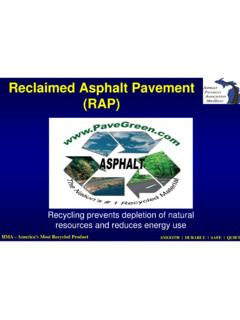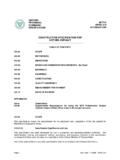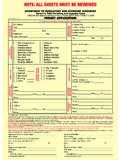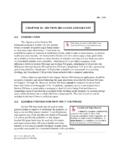Transcription of 4RATING 10RATING P Asphalt Roads P - apa-mi.org
1 PASERA sphalt RoadsPavement Surface Evaluation and RatingPASERM anualAsphalt RoadsRATING10 RATING4 RATING7 RATING1 This manual is intended to assist local officials in understanding andrating the surface condition of Asphalt pavement. It describes types of defects and provides a simple system to visually rate pavementcondition. The rating procedure can be used as condition data for theWisconsin DOT local road inventory and as part of a computerizedpavement management system like PASER system described here and in other publications isbased in part on a roadway management system originally developedby Phil Scherer, transportation planner, Northwest Wisconsin RegionalPlanning by the with support from the Federal HighwayAdministration, the Wisconsin Department of Transportation, and theUniversity of Wisconsin-Extension.
2 The , part of the nationwideLocal Technical Assistance Program (LTAP), is a Center of the College of Engineering, Department of Engineering Professional Development,University of Wisconsin Surface Evaluation and Rating (PASER) ManualsAsphalt PASER Manual, 2002, 28 pp. Brick and Block PASER Manual, 2001, 8 PASER Manual, 2002, 28 PASER Manual,2002, 20 pp. Sealcoat PASER Manual,2000, 16 Roads PASER Manual, 2001, 12 ManualLocal road Assessment and Improvement, 2000, 16 ManualSafety Evaluation for Roadways, 1996, 40 s Handbook (pocket-sized guide), 1998, 22 Zone Safety, Guidelines for Construction, Maintenance, and Utility Operations, (pocket-sized guide), 1999, 55 Transportation Bulletins#1 Understanding and Using Asphalt #2 How Vehicle Loads Affect Pavement Performance#3 LCC Life Cycle Cost Analysis#4 road Drainage#5 Gravel Roads #6 Using Salt and Sand for Winter road Maintenance#7 Signing for Local Roads #8 Using Weight Limits to Protect Local Roads #9 Pavement Markings#10 Seal Coating and Other Asphalt Surface Treatments#11 Compaction Improves Pavement Performance#12 Roadway Safety and Guardrail#13 Dust Control on Unpaved Roads #14 Mailbox Safety#15 Culverts-Proper Use and Installation#16 Geotextiles in road Construction/Maintenance and Erosion Control#17 Managing Utility Cuts#18 Roadway Management and Tort Liability in
3 Wisconsin#19 The Basics of a Good road #20 Using Recovered Materials in Highway Construction#21 Setting Speed Limits on Local RoadsCopyright 1987, 1989, 2002 Wisconsin Transportation Information Center432 North Lake StreetMadison, WI on recycled North Lake StreetMadison, WI pavement distress3 Evaluation4 Surface defects4 Surface deformation5 Cracking7 Patches and potholes12 Rating pavement surface condition14 Rating system15 Rating 10 & 9 Excellent16 Rating 8 Very Good17 Rating 7 Good18 Rating 6 Good19 Rating 5 Fair20 Rating 4 Fair21 Rating 3 Poor22 Rating 2 Very Poor23 Rating 1 Failed25 Practical advice on rating roads26 TransportationInformationCenterPublicati onsDonald Walker, Director,authorLynn Entine, Entine & Associates,editorSusan Kummer, Artifax,designerPASERM anualPavement Surface Evaluation and RatingAsphalt RoadsA local highway agency s major goal is to use public funds to provide acomfortable.
4 Safe and economical road surface no simple task. It requiresbalancing priorities and making difficult decisions in order to managepavements. Local rural and small city pavements are often managed informally,based on the staff s judgment and experience. While this process is bothimportant and functional, using a slightly more formalized technique can makeit easier to manage pavements has shown that there are three especially useful steps inmanaging local Roads :1. Inventory all local Roads and Periodically evaluate the condition of all Use the condition evaluations to set priorities for projects and select alternative comprehensive pavement management system involves collecting data andassessing several road characteristics: roughness (ride), surface distress(condition), surface skid characteristics, and structure (pavement strength anddeflection).
5 Planners can combine this condition data with economic analysis todevelop short-range and long-range plans for a variety of budget , many local agencies lack the resources for such a full-scale surface condition is the most vital element in any pavementmanagement system, local agencies can use the simplified rating systempresented in this Asphalt PASER Manualto evaluate their Roads . The PASER ratings combined with other inventory data (width, length, shoulder, pavementtype, etc.) from the WisDOT local Roads inventory (WISLR) can be very helpful inplanning future budgets and inventory information and PASER ratings can be used in acomputerized pavement management system, PASERWARE, developed by and WisDOT.
6 Local officials can use PASERWARE to evaluate whether theirannual road budgets are adequate to maintain or improve current roadconditions and to select the most cost-effective strategies and priorities forannual Manuals for gravel, concrete , and other road surfaces, withcompatible rating systems are also available (page 29). Together they make acomprehensive condition rating method for all road types. PASER ratings areaccepted for WISLR condition Surface Evaluation and RatingAsphalt PASERM anualPASER Evaluation3 Asphalt pavement distressPASER uses visual inspection to evaluate pavement surface conditions. The keyto a useful evaluation is identifying different types of pavement distress andlinking them to a cause.
7 Understanding the cause for current conditions isextremely important in selecting an appropriate maintenance or are four major categories of common Asphalt pavement surfacedistress:Surface defectsRaveling, flushing, deformationRutting, distortion rippling and shoving, settling, frost Transverse, reflection, slippage, longitudinal, block, and alligator and potholesDeterioration has two general causes: environmental due to weathering andaging, and structural caused by repeated traffic , most pavement deterioration results from both environmental andstructural causes. However, it is important to try to distinguish between thetwo in order to select the most effective rehabilitation rate at which pavement deteriorates depends on its environment, trafficloading conditions, original construction quality, and interim maintenanceprocedures.
8 Poor quality materials or poor construction procedures cansignificantly reduce the life of a pavement. As a result, two pavementsconstructed at the same time may have significantly different lives, or certainportions of a pavement may deteriorate more rapidly than others. On the otherhand, timely and effective maintenance can extend a pavement s life. Cracksealing and seal coating can reduce the effect of moisture in aging of all of these variables, it is easy to see why pavements deteriorate atvarious rates and why we find them in various stages of disrepair. Recognizingdefects and understanding their causes helps us rate pavement condition andselect cost-effective repairs.
9 The pavement defects shown on the followingpages provide a background for this inspection is necessary to provide current and useful evaluation is recommended that PASER ratings be updated every two years, and anannual update is even Surface Defects4 SURFACE DEFECTSR avelingRaveling is progressive loss of pavementmaterial from the surface downward,caused by: stripping of the bituminousfilm from the aggregate, Asphalt hard-ening due to aging, poor compactionespecially in cold weather construction,or insufficient Asphalt content. Slight tomoderate raveling has loss of raveling has loss of coarseaggregate. Raveling in the wheelpathscan be accelerated by traffic. Protectpavement surfaces from the environ-ment with a sealcoat or a thin overlay if additional strength is is excess Asphalt on thesurface caused by a poor initial asphaltmix design or by paving or sealcoatingover a flushed surface.
10 Repair by blot-ting with sand or by overlaying withproperly designed Asphalt is a smooth slippery surfacecaused by traffic wearing off sharpedges of aggregates. Repair withsealcoat or thin bituminous overlayusing skid-resistant aggregateparticles haveworn awayexposing topsof tosevere furtherexposes ravelingand loss Darkpatches showwhere asphalthas worked to , wornaggregateneeds repair. EVALUATION Surface Deformation5 SURFACE DEFORMATIONR uttingRutting is displacement of material,creating channels in wheelpaths. It is caused by traffic compaction ordisplacement of unstable rutting (over 2 ) may be caused by base or subgrade consolidation. Repair minor rutting with overlays.







